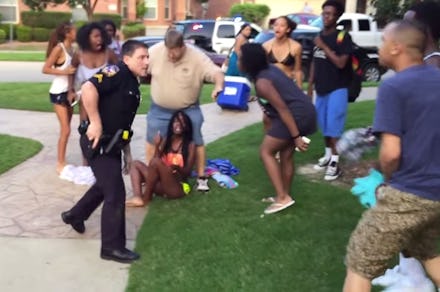The McKinney Police Incident Revealed Much More Than Bad Policing

The video of a white male police officer forcibly apprehending and assaulting black teenagers in McKinney, Texas, on Friday is an appalling example of the seeming daily occurrence of blue-on-black violence in the U.S.
Police arrived on the scene in response to a report of "a disturbance at the Craig Ranch North Community Pool," according to a post on the McKinney Police Department Facebook page, where the teens were reportedly not allowed to be. The situation escalated as officers began singling out black teenagers.
A video of the altercation shows black boys being forced to sit on the ground. Some boys are handcuffed as an officer hurls profanity at them. The same officer grabs a black girl dressed in a bathing suit and slams her to the ground. He even pulls out a gun as he moves toward a few black teens attempting to intervene.
It all happens in the presence of several mostly white bystanders who, as seen in the video, do nothing to stop the abuse.
The pervasive pattern of police abuse in the U.S. is one problem. Public silence — including the silence of bystanders — in response to police abuse is another.
The McKinney fiasco seems to be a lesson in the dangerous consequences of acquiescence. One white adult witness can be seen aggressively positioning his body directly above the black girl who had been thrown and held to the ground by the hyper-aggressive police officer. Other witnesses can be seen walking by without stopping, or standing in close distance without saying anything to the police and youth.
Moving toward or questioning an angry, gun-happy officer, like the officer seen in the video, are actions most people would consider foolish, especially considering people have been killed for doing much less. In September 2013, for example, 24-year-old Jonathan Ferrell was fatally shot by a police officer in Charlotte, North Carolina, as he approached the officer for assistance after getting into a car accident. The steps Ferrell took toward an officer and his plea for help were read as an act of aggression; the stakes for potential harm might be much higher for those attempting to intervene in moments when police are brutalizing civilians.
Nevertheless, people who passively witness police abuse are complicit participants in the violence if they do nothing. Fear is an understandable response to police violence, but silence in moments when victims are being assaulted by police can be an indication onlookers think the abuse is warranted.
Of course, it's complicated for people of color especially to intervene; the fear that may compel these individuals to remain silent is a consequence of widespread police abuse in black and brown communities. Yet intervention can take different forms, and in this time of rabid police abuse, we must ask ourselves what community accountability looks like.
Unlike the black and brown teens who were apprehended, yelled at, handcuffed, slammed to the ground or nearly fired on for coming to the aid of a friend, 15-year-old Brandon Brooks was able to record in close proximity to the police. The fact that Brooks was seemingly allowed to record without retribution was likely due in part to the fact that he is a white resident. Nevertheless, his intervention may be the one reason the victims could have a chance at securing justice.
Recording videos is one way to intervene when witnessing acts of violence. Speaking up, asking victims if they need assistance and noting important details upon encountering interactions between police and civilians may not result in legal action against abusive police officers; they may not result in someone's life being saved either. But these acts can potentially bring about more accountability for police.
The abuse of Eric Garner, who was choked to death by police in New York City, was recorded and the officer still escaped indictment. The shooting of Walter Scott by Officer Michael Slager in North Charleston, South Carolina, was also recorded, and Slager was indicted on murder charges on Monday. Though the outcome differed, in both cases, the public had additional proof that police forces are in need of critical changes.
Active observation of police abuse is a clear indication a problem is occurring. Passive voyeurism is an indication that public silence is just as insidious as bad officers and police departments.